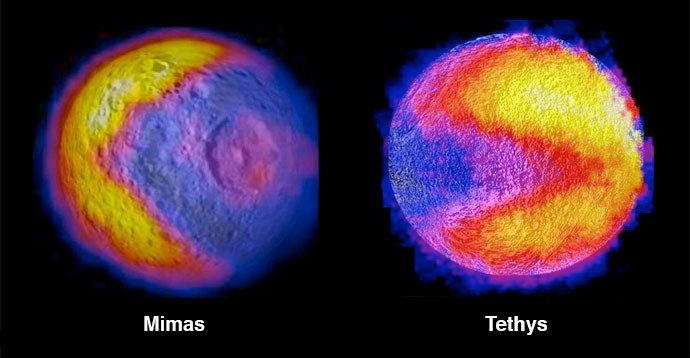Second Pac-Man Found on Saturn Moon

A second Pac-Man has been spotted on Saturn after one appeared on a thermal image of one of the planet's moons in 2010.
The first Saturn Pac-Man was seen on Mimas and now a second has been spotted on another moon named Tethys.
Nasa scientists with the Cassini mission have dubbed the new find "Pac-Man, the Sequel".
Carly Howett, the lead author of an online paper in the journal Icarus, said: "Finding a second Pac-Man in the Saturn system tells us that the processes creating these Pac-Men are more widespread than previously thought.
"The Saturn system - and even the Jupiter system - could turn out to be a veritable arcade of these characters."
Pac-Man was created by Toru Iwatini after he saw two slices of pizza short of a full circle. At the age of 27, he came up with the idea for the game and just a few years later, Pac-Man was a household name.
The name Pac-Man comes from the Japanese term Paku-Paku, which is the sound of munching.
The thermal Pac-Man data was obtained by Cassini's composite infrared spectrometer, with warmer areas showing the shape of the classic arcade game.
Evolution of Saturn's moons
Scientists think the shape occurs because high-energy electrons are bombarded with low latitudes from the side of the moon that faces forward, as it orbits around Saturn. This barrage turns the surface into hard-packed ice.
Consequently, the hard surface does not heat as rapidly in the sunshine or cool down as fast at night compared with the rest of the surface.
The discovery of a second Pac-Man provides further evidence that energy electrons can significantly shift the surface of an icy moon.
Linda Spilker, Cassini project scientist at Nasa's Jet Propulsion Laboratory, said: "Finding a new Pac-Man demonstrates the diversity of processes at work in the Saturn system.
"Future Cassini observations may reveal other new phenomena that will surprise us and help us better understand the evolution of moons in the Saturn system and beyond."
Mike Flasar, principal investigator at Nasa's Goddard Space Flight Centre, added: "Studies at infrared wavelengths give us a tremendous amount of information about the processes that shape planets and moons. A result like this underscores just how powerful these observations are."
Temperatures inside Pac-Man's mouth are 29F Fahrenheit cooler than "his" face. The warmest temperature recorded was minus 300F.
© Copyright IBTimes 2025. All rights reserved.






















